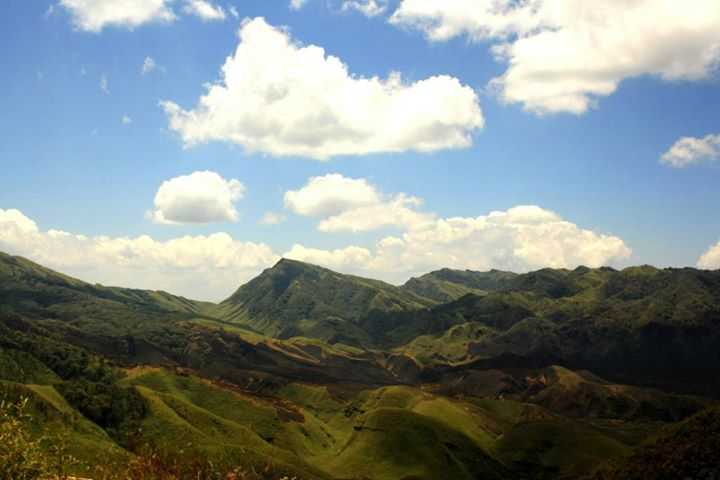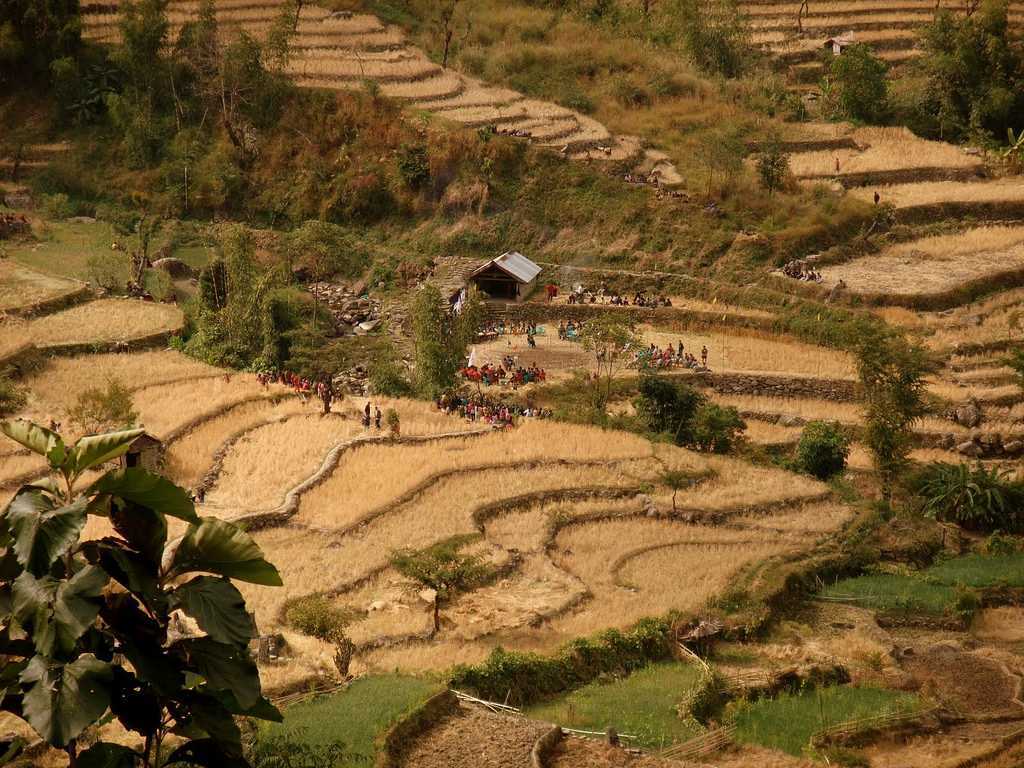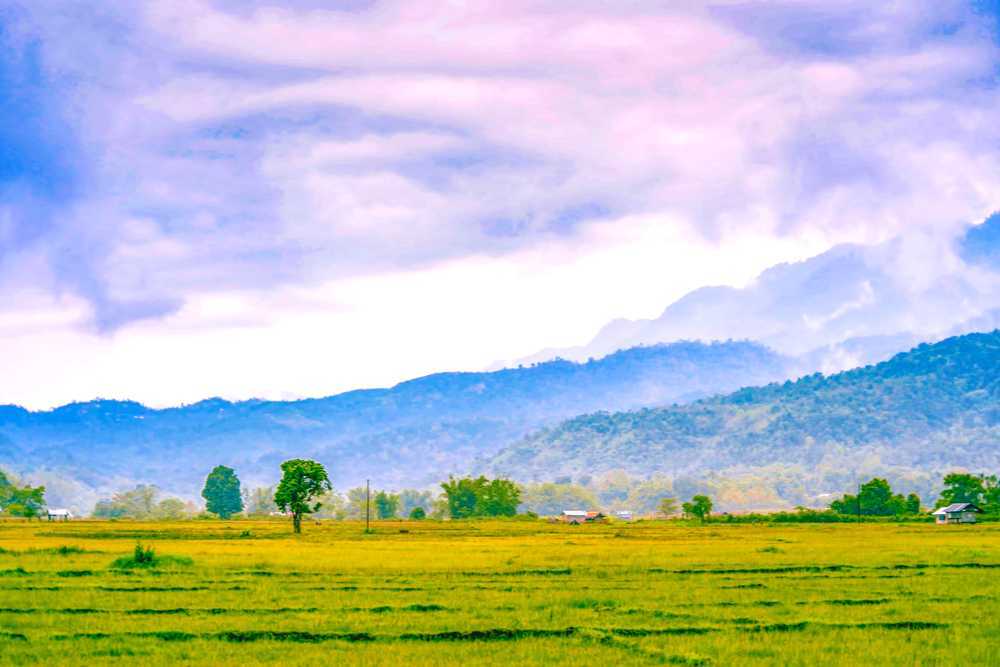NAGA HERITAGE VILLAGE
Hey there, fellow travel enthusiasts! Are you tired of visiting the same old touristy destinations with their overpriced souvenir shops and crowded streets? Do you want to experience something unique, authentic and oh-so-entertaining? Well then, let me introduce you to the Naga Heritage Village – a place that will transport you back in time and make you forget all your worries.
Located in the serene hills of Nagaland, this cultural extravaganza is a must-visit for anyone who wants to explore the rich history and traditions of the Naga people. From their vibrant dances and folk songs to their mouth-watering cuisine and intricate handicrafts, every aspect of their culture is on display here.
But wait, it's not just about learning and observing – the Naga Heritage Village is also a hub of fun and frolic. Imagine participating in traditional games like bamboo stilt-walking or tug-of-war with locals who are as competitive as they are hospitable. Or how about trying your hand at weaving baskets or making pottery under the guidance of skilled artisans?
And if that's not enough to convince you, let me tell you that the Naga Heritage Village hosts an annual Hornbill Festival – a week-long celebration of all things Naga that attracts visitors from all over the world. So what are you waiting for? Pack your bags and head over to Nagaland – where adventure meets culture meets laughter!
Table of Contents
- Introduction
- History and Culture of Naga Heritage Village
- How to Reach and getting around Naga Heritage Village
- Weather of Naga Heritage Village
- Places to Visit in Naga Heritage Village
- Food Options and Local Cuisine of Naga Heritage Village
- Best areas for Accommodation in Naga Heritage Village
- Shopping in Naga Heritage Village
- Nightlife in Naga Heritage Village
- Festivals and Events in Naga Heritage Village
- Tips for Travelers travelling to Naga Heritage Village
- FAQs
History and Culture of Naga Heritage Village
One of the most fascinating cultural destinations in India is the Naga Heritage Village. This village is located near Kohima, the capital city of Nagaland. It is a living museum that showcases the rich and diverse culture of the Naga people. The history of this village goes back to ancient times when the Naga tribes lived in small hamlets across the region.
Legend has it that long ago, a powerful sorcerer cast a spell on the villagers, turning them into stone. The only way to break the spell was for someone to perform a dance ritual that would wake them up. After many years, a brave warrior from one of the neighboring villages stumbled upon these petrified villagers and decided to save them.
Today, this heritage village is a popular tourist destination where visitors can experience Naga culture firsthand. It features traditional Naga huts, crafts, food stalls, and live performances by local artists. Visitors can also try their hand at weaving and other traditional crafts.
The best time to visit this village is during the Hornbill Festival, which takes place every December. This festival celebrates Naga culture and traditions with music, dance, food fairs, and sporting events.
Overall, visiting the Naga Heritage Village is an excellent way to learn about and appreciate Nagaland's rich cultural heritage while having fun at the same time!
How to Reach and getting around Naga Heritage Village
Naga Heritage Village is a must-visit for those interested in history and culture. Here are some specific ways to reach the village.
By air: The nearest airport is Dimapur Airport, which is around 74 kilometers away from the village. From there, you can take a taxi or hire a car to reach the village.
By train: The nearest railway station is Dimapur Railway Station, which is around 72 kilometers away from the village. You can take a taxi or hire a car from the railway station to reach the village.
By road: The village is well-connected by road to nearby towns and cities. You can take a bus or hire a car from Guwahati, which is around 350 kilometers away from the village.
By bike: If you're an adventurous traveler, you can rent a bike and ride to the village through scenic routes. However, keep in mind that some of the roads may be challenging and require experience in riding on hilly terrain.
By trekking: For those who love trekking, there are several trails that lead to the village through lush forests and hills. This option requires physical fitness and proper gear for trekking.
No matter which option you choose, make sure to plan your trip in advance and carry essential items like water bottles, snacks, and first-aid kits. Enjoy your journey to Naga Heritage Village!
Weather of Naga Heritage Village












 Extreme Winters
Extreme Winters Mild Winters
Mild Winters Hot + Dry
Hot + Dry Hot + Humid
Hot + Humid Rainy
Rainy Cool and Pleasant
Cool and PleasantThe weather in Naga Heritage Village is generally pleasant throughout the year, with a humid subtropical climate. However, the best time to visit Naga Heritage Village is between October and March.
During this time, the weather is cool and dry, making it ideal for exploring the village and its surroundings. The temperatures range from 10°C to 20°C, which is perfect for sightseeing without feeling too hot or cold.
In contrast, the monsoon season in Naga Heritage Village lasts from May to September. The rains can be heavy and continuous during this period, which can make it difficult to explore the village. Moreover, landslides are quite common during this time, which can lead to road closures.
It is important to note that Naga Heritage Village hosts an annual Hornbill Festival in December every year. This festival showcases the rich culture and traditions of Nagaland and attracts a large number of tourists from all over India and beyond. Therefore, if you plan to visit during this time, it is recommended to book your accommodation well in advance.
Overall, if you want to enjoy a pleasant climate and explore the cultural heritage of Nagaland without any hindrance, the best time to visit Naga Heritage Village is between October and March.
Places to Visit in Naga Heritage Village
The Main Gate - The entrance to the Naga Heritage Village is an impressive wooden archway that features traditional Naga motifs and carvings. It's the perfect place to start your journey through the village.
The Morung - A Morung is a traditional Naga communal house where young boys and girls were trained in various aspects of life, including hunting, farming, weaving, and crafts. At the Heritage Village, visitors can see a reconstructed Morung and learn about its cultural significance.
The Kitchen Hut - One of the most important structures in any Naga village is the kitchen hut. Here, visitors can witness traditional cooking methods and sample local delicacies.
The Craft Centre - The Craft Centre showcases various traditional Naga handicrafts like bamboo baskets, pottery, and weaving. Visitors can also purchase these items as souvenirs.
The Tribal Art Gallery - This gallery houses a collection of tribal art from across Nagaland. Visitors can view intricate wood carvings, paintings, sculptures, and more.
The Stone Bridge - A unique feature of the heritage village is a stone bridge that connects two hillsides over a small stream. It was built without any cement or modern tools using only stones found in the area.
The Village Square - In every Naga village, the central square serves as a gathering place for community events like festivals and dances. At the Heritage Village, visitors can witness traditional dances performed by local artists.
The Shaman's Hut - Shamans are an integral part of Naga culture who serve as spiritual healers and advisors to their communities. At the Heritage Village, visitors can learn about their practices and beliefs at a reconstructed Shaman's Hut.
The War Memorial - Nagaland has a history of conflict dating back to World War II when it was used as a battlefield between Allied forces and Japanese troops. A War Memorial at the Heritage Village honors those who lost their lives during this time.
The Bamboo Cathedral - Built entirely with bamboo poles lashed together with cane ropes, this unique structure serves as a venue for religious ceremonies and cultural events throughout the year.
Overall, visiting these ten must-see places in Naga Heritage Village will give you an insight into Nagaland's rich culture and history while providing an unforgettable experience of its vibrant traditions and customs that have been preserved for generations to come!
Relaxing Retreats
Hilly Regions
Nearby Forests
Food Options and Local Cuisine of Naga Heritage Village
Best areas for accommodation in Naga Heritage Village
Naga heritage village is a popular tourist destination in Nagaland, India. It is a place where one can experience the rich cultural heritage of the Naga tribes. If you are planning to visit this place, it is essential to choose the right accommodation that suits your budget and preferences. Here are some of the best areas for accommodation in Naga heritage village:
Morung Camp: This area has several traditional huts called morungs that offer an authentic Naga experience. The huts have basic amenities, and you can also enjoy bonfires and cultural performances here.
Kisama Village: This is the hub of the Naga heritage village and has several guesthouses, resorts, and hotels. It has better amenities than other areas but can be slightly expensive.
Dzukou Valley: If you want to stay amidst nature, Dzukou Valley is an ideal location. It offers various camping options with stunning views of lush green valleys.
Here are some of the best properties for accommodation in Naga heritage village:
Dzükou Valley Trek and Camping: This luxury property offers camping options in Dzükou Valley with comfortable tents, meals, and guided treks.
Kisama Heritage Guest House: This budget-friendly property offers cozy rooms with basic amenities like a TV and hot water facility.
Morung Lodge Hostel: This hostel provides an authentic Naga experience with traditional morungs as dormitories. It also has a common kitchen where guests can cook their meals.
Choose any of these properties based on your budget and preferences to have an enjoyable stay at Naga heritage village.
Shopping in Naga Heritage Village
If you are visiting Nagaland, shopping in the Naga Heritage Village is a must-do activity. This village is located in Kisama, Kohima and offers a unique shopping experience. The village showcases the rich cultural heritage of Nagaland and offers an array of handicrafts, textiles, and jewelry that represent the state's art and culture.
Things to buy
Here are four things you should consider buying when visiting the Naga Heritage Village:
- Handwoven shawls: These shawls come in various colors and designs and are made from natural fibers such as cotton, silk, or wool.
- Bamboo handicrafts: Nagaland is known for its bamboo crafts such as baskets, trays, furniture, and decorative items.
- Beaded jewelry: The state's tribes use beads to make intricate jewelry pieces such as necklaces, bracelets, earrings, etc.
- Spices: Nagaland is famous for its spices such as bhut jolokia (ghost pepper) and naga king chili.
Markets to visit
Here are three markets that you should visit when shopping at the Naga Heritage Village:
- State Emporium: This market offers an extensive collection of traditional handloom textiles such as shawls, scarves, bags, etc.
- Craft Bazaar: This market sells various handicrafts made by local artisans such as bamboo products, wood carvings, pottery items.
- Souvenir Shop: This shop has an assortment of souvenirs like keychains, fridge magnets with traditional Naga motifs.
What to avoid
Here are four things you should avoid buying when shopping in the Naga Heritage Village:
- Wildlife products: It is illegal to buy or sell wildlife products like ivory or animal skins.
- Fake products: Avoid buying fake items that claim to be authentic handicrafts made by local artisans.
- Non-local goods: Try to avoid buying goods that are not locally made as it would not support the local economy.
- Expensive items: Some vendors may try to overcharge tourists for their goods. Be aware of the prices of items beforehand.
Overall shopping at Naga Heritage Village can be a rewarding experience for tourists who want to take home some authentic souvenirs that depict Nagaland’s rich culture.
Nightlife in Naga Heritage Village
Naga Heritage Village Nightlife
Naga Heritage Village is a popular tourist destination in Nagaland, known for its rich culture, traditions and heritage. The village is also famous for its vibrant nightlife that offers visitors a chance to experience the local way of life after the sun goes down.
The nightlife in Naga Heritage Village revolves around music, dance and local cuisine. Visitors can enjoy traditional Naga music and dance performances throughout the night while indulging in local delicacies and drinks.
If you're looking for places to spend the night in Naga Heritage Village, here are three suggestions:
The Bamboo Cottage - This rustic cottage provides a unique experience of staying amidst nature with all modern amenities. It's perfect for those who want to escape the city and enjoy some quiet time under the stars.
Campsite by Dzükou Valley - This campsite is located near Dzükou Valley, one of the most scenic places in Nagaland. Visitors can spend the night camping under the stars while enjoying bonfires and barbecues.
Kohima Night Market - The Kohima Night Market is a must-visit place for those who love street food and shopping. The market comes alive at night with local vendors selling everything from clothes to handicrafts and delicious local food.
In conclusion, Naga Heritage Village offers a unique nightlife experience that combines traditional music, dance and cuisine with modern amenities. It's an ideal destination for those who want to explore Nagaland's rich cultural heritage while enjoying some fun-filled nights out.
Outdoor Activities in Naga Heritage Village
If you're looking for some outdoor activities to do in Naga heritage village during the day, there are plenty of options available. The village is surrounded by lush greenery and scenic landscapes, making it the perfect place to explore nature. You can take a leisurely hike through the forests, go bird watching, or even go on a cycling tour around the village.
One of the most popular activities in the area is trekking. There are several trails that you can choose from, each offering a unique experience. The Dzukou Valley trek is one of the most challenging ones, but it is also one of the most rewarding. The trail takes you through dense forests and steep hills, offering breathtaking views of the valley below.
If you're looking for something less strenuous, you can opt for a cycling tour around the village. This is a great way to explore the area and get up close with nature. You'll be able to see local wildlife and enjoy stunning views of the surrounding mountains.
Finally, if you're interested in bird watching, Naga heritage village has plenty of opportunities for that as well. The area is home to a wide variety of bird species, including rare ones like the Blyth's Tragopan and Rufous-necked Hornbill. You can take a guided tour with an experienced birder who will help you spot these beautiful creatures in their natural habitat.
- Trekking
- Cycling tour
- Bird watching
Festivals and Events in Naga Heritage Village
Festivals and events play a crucial role in the cultural heritage of Naga people. These events celebrate their rich history, traditions, and customs. Moreover, these festivals also provide an opportunity for people to come together and rejoice in the spirit of community. The Naga Heritage Village is a place where one can experience these festivals and events up close.
Some of the popular festivals and events celebrated in Naga Heritage Village are:
Hornbill Festival (December): This is one of the biggest festivals celebrated in Nagaland, which showcases the best of Naga culture, food, music, and dance.
Moatsu Festival (May): This festival is celebrated by the Ao tribe to welcome the spring season. People dress up in traditional attire and perform folk songs and dances.
Sekrenyi Festival (February): This festival is celebrated by the Angami tribe to seek blessings from their ancestors. People sing traditional songs, perform dances and feast on local delicacies.
Tuluni Festival (July): This festival is celebrated by Sumi Nagas to mark the arrival of monsoon season. People wear colorful attires, perform traditional dances and enjoy local cuisine.
Apart from these festivals, there are other events like:
Nagaland Statehood Day (December 1): Celebrated to commemorate Nagaland's statehood day.
International Music Festival (October): A three-day music festival that brings together musicians from across India and abroad.
Naga Chef Season 4 (October-November): A cooking competition that showcases traditional Naga cuisine.
These festivals and events in Naga Heritage Village provide an excellent opportunity for tourists to experience Nagaland's unique culture firsthand.
Tips for Travelers while travelling to Naga Heritage Village
- Plan ahead and research the festivals and events happening in Naga heritage village ahead of time. This will help you plan your trip accordingly and ensure that you don't miss out on any of the cultural experiences that make this village so unique.
- Respect local customs and traditions while attending festivals and events. The Naga people have a rich cultural heritage, so it's important to be mindful of local customs, dress codes, and etiquette to show your appreciation for their traditions.
- Stay hydrated during the hot and humid summer months in Naga heritage village. Carry a water bottle with you at all times and drink plenty of fluids to avoid dehydration.
- Wear comfortable clothing that is appropriate for the weather conditions in the region. This may mean wearing light, breathable clothing during the summer months or bringing warm layers for cooler evenings during the winter season.
- Engage with locals to learn more about their culture and way of life. The people of Naga heritage village are friendly and welcoming, so don't be afraid to strike up a conversation or ask questions about their traditions, food, or language.
Overall, visiting Naga heritage village is a wonderful opportunity to immerse yourself in the rich cultural traditions of this fascinating region. By following these tips, you can ensure that your trip is safe, enjoyable, and respectful of local customs.
FAQs
What is Naga Heritage Village?
Naga Heritage Village is an open-air museum located in Kisama, Nagaland, India. It was established to preserve and showcase the culture and traditions of the Naga tribes.
What are the activities one can do in Naga Heritage Village?
Visitors can witness traditional dance performances, participate in workshops on weaving, wood carving, and bamboo craft, taste traditional Naga food, and shop for handicrafts made by local artisans.
What are the timings of Naga Heritage Village?
The village remains open from 9:00 AM to 4:30 PM every day except on Sundays when it is closed.
How much is the entry fee for Naga Heritage Village?
The entry fee for Indian citizens is INR 30 per person, while foreign nationals have to pay INR 100 per person. Children below five years of age can enter free of charge.
What are some important things to keep in mind while visiting Naga Heritage Village?
Visitors should dress modestly and avoid revealing clothing as a mark of respect towards the local culture. Photography is allowed but only after seeking permission from the concerned authorities. Visitors should also avoid littering and maintain cleanliness within the premises.
Are there any special events or festivals celebrated at Naga Heritage Village?
Yes, during the Hornbill Festival held every year in Nagaland from December 1st to 10th, Naga Heritage Village becomes a hub of cultural activities with traditional performances, handicrafts exhibitions, food stalls showcasing local cuisine, and much more.
Is there any accommodation available at or near Naga Heritage Village?
Yes, visitors can choose from a range of accommodation options near Kisama including homestays and guesthouses. However, it is advisable to book in advance during peak tourist season as availability may be limited.




